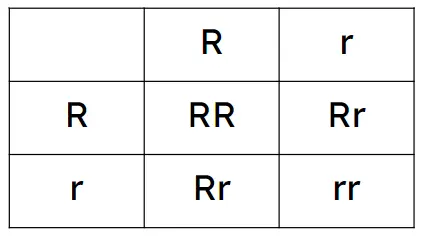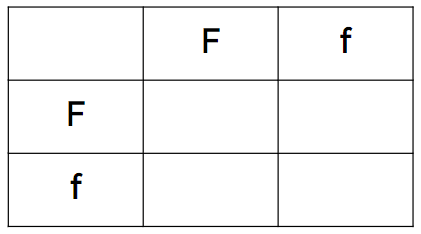Myths about teaching can hold you back
- Year 10
- OCR
- Foundation
Models of single-gene inheritance: Punnett squares
I can interpret and construct Punnet squares to show the inheritance of alleles of a single gene.
- Year 10
- OCR
- Foundation
Models of single-gene inheritance: Punnett squares
I can interpret and construct Punnet squares to show the inheritance of alleles of a single gene.
These resources were made for remote use during the pandemic, not classroom teaching.
Switch to our new teaching resources now - designed by teachers and leading subject experts, and tested in classrooms.
Lesson details
Key learning points
- Most characteristics are influenced by multiple genes, but some are determined by just one.
- An individual will inherit two alleles for each gene, the alleles for a gene may be dominant or recessive.
- A Punnett square models inheritance of alleles showing possible genotypes of offspring as homozygous or heterozygous.
- Punnett squares are used to predict proportion of genotypes/phenotypes, or probability of occurrence in the offspring.
- Each instance of sexual reproduction is independent, so does not affect the probability for subsequent offspring.
Keywords
Punnett square - A model used to show the inheritance of alleles from parents to offspring.
Gamete - A sex cell (i.e. sperm and egg) that carries half the genetic information required for an individual organism.
Genotype - The combination of alleles that an individual has for each gene.
Ratio - Shows hows how much of one value there is compared to another.
Probability - A measure of the chance or likelihood of an event occurring.
Common misconception
A gamete has two alleles, Punnett square has too many alleles for gametes. Also that only four offspring are produced and therefore each will definitely have the genotype and phenotype shown.
Model the alleles within gametes so it is clear. Refer to half the gametes having each version, moving away from the idea of divisions of 4.
To help you plan your year 10 combined science lesson on: Models of single-gene inheritance: Punnett squares, download all teaching resources for free and adapt to suit your pupils' needs...
To help you plan your year 10 combined science lesson on: Models of single-gene inheritance: Punnett squares, download all teaching resources for free and adapt to suit your pupils' needs.
The starter quiz will activate and check your pupils' prior knowledge, with versions available both with and without answers in PDF format.
We use learning cycles to break down learning into key concepts or ideas linked to the learning outcome. Each learning cycle features explanations with checks for understanding and practice tasks with feedback. All of this is found in our slide decks, ready for you to download and edit. The practice tasks are also available as printable worksheets and some lessons have additional materials with extra material you might need for teaching the lesson.
The assessment exit quiz will test your pupils' understanding of the key learning points.
Our video is a tool for planning, showing how other teachers might teach the lesson, offering helpful tips, modelled explanations and inspiration for your own delivery in the classroom. Plus, you can set it as homework or revision for pupils and keep their learning on track by sharing an online pupil version of this lesson.
Explore more key stage 4 combined science lessons from the Inheritance, genotype and phenotype unit, dive into the full secondary combined science curriculum, or learn more about lesson planning.

Licence
Prior knowledge starter quiz
6 Questions
Q1.Which is the genetic code?
Q2.Which statement best describes the relationship between phenotype and genotype?
Q3.Horse body cells have 64 chromosomes. How many chromosomes will there be in a horse's unfertilised egg cell?
Q4.True or false? Offspring inherit different genes from each parent.
Q5.In humans the CF protein affects the stickiness of mucus. There are two alleles F and f. Individuals with the genotype ff have very sticky mucus. Which allele is dominant?
Q6.Plants produce either red pigmented flowers or white flowers with no pigment. The RR or Rr genotypes have red flowers. Plants with rr genotype have white flowers. Order the statements to explain how.
Assessment exit quiz
6 Questions
Q1.Match the word to its meaning.
has two different alleles for a gene
has two identical alleles for a gene
a measure of the chance of an event happening
shows how much of one value there is compared to another
Q2.The nucleus of a chimpanzee body cell contains 48 chromosomes. How many chromosomes will there be in the nucleus of a chimpanzee zygote?
Q3.A woman is heterozygous (Ff) for the gene that codes for a protein. What genotypes can her eggs have?
Q4.Two heterozygous (Rr) red flowered plants cross pollinate each other. Use the Punnett square to work out the ratio of red : white flowering offspring.

Q5.A couple who are both heterozygous (Ff) for the A gene want to have a child. Use the incomplete Punnett square to work out the probability that the child will be homozygous recessive.



